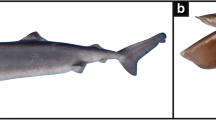Abstract
Scarce bycatches of Cookiecutter Shark (Isistius brasiliensis) is the reason why this species is easier studied through the marks they leave on their prey rather than by direct observation of the shark itself. However, scientific studies that have used ichnology to remedy this lack of knowledge have been probably based on mistaken assumptions transmitted among previous authors without due verification. Despite identifying the problem almost twenty years ago, the authors of this paper were unable to obtain a sufficient number of Cookiecutter Shark specimens until now in order to confirm their hypothesis. This work provides a set of biometrics of Cookiecutter Shark specimens among which worth highlighting is the measure of the lower jaw width (LJW), which was absent in the relevant literature. This parameter is crucial for correcting the linear regression between total length and mouth width on which earlier biogeographical works were based. The new linear regression obtained using LJW was later applied to the bites observed on Swordfish caught in the Gulf of Guinea in 1996. The results show a probability of 0.50 for Cookiecutter Shark attack on Swordfish in the study area (29.4% of Swordfish bitten), and a positive correlation between predator and prey sizes. The lengths of Cookiecutter Shark inferred from bite size on sampled Swordfish revealed a certain geographical disaggregation in the area, with older individuals, probably females, concentrating in waters near the mouth of the Congo River.








Similar content being viewed by others
References
Breiman L, Friedman JH, Olshen RA, Stone CJ (1984) Classification and regression trees. Chapman & Hall/CRC, Boca Raton
Cadenat J, Blache J (1981) Requin de Mediterranee et d’Atlantique (Plus Particulierement de la Cote Occidentale d’Afrique) (Faune Tropicale, vol. 21). Office de la Recherche Scientifique et Technique Outre-Mer, Paris
Compagno L (1984) FAO species catalogue, Vol. 4, Part 1: Sharks of the World. An Annotated and Illustrated Catalogue of Shark Species Known to Date. FAO, Rome
Compagno L, Dando M, Fowler S (2005) Sharks of the world. Princeton University Press, Princeton
Ebert DA (2003) Sharks, rays and chimaeras of California. California natural history guides no. 71. University of California Press, Berkeley. p e284
Hiruki LM, Gilmartin WG, Becker BL, Stirling I (1993) Wounding in Hawaiian monk seals (Monachus schauinslandi). Can J Zool 71(3):458–468. https://doi.org/10.1139/z93-066
IUCN (2017) The IUCN Red List of Threatened Species. Version 2017-2. www.iucnredlist.org. Accessed 28 Sept 2017
Jones EC (1971) Isistius brasiliensis, a squaloid shark, the probable cause of crater wounds on fishes and cetaceans. Fish Bull 69:791–798
Le Boeuf BJ, McCosker JE, Hewitt J (1987) Crater wounds on northern elephant seals: the Cookiecutter shark strikes again. Fish Bull 85(2):387–392
Moroshkin KV, Bunov VA, Bulatov RP (1970) Water circulation in the eastern South Atlantic Ocean. Oceanology 10:27–34
Muñoz-Chapuli R, Rey Salgado JC, De La Serna JM (1988) Biogeography of Isistius brasiliensis in the north-eastern Atlantic, inferred from crater wounds on swordfish (Xiphias gladius). J Mar Biol Assoc UK 68(02):315–321. https://doi.org/10.1017/S0025315400052218
Papastamatiou YP, Wetherbee BM, O’Sullivan J, Goodmanlowe GD, Lowe CG (2010) Foraging ecology of Cookiecutter sharks (Isistius brasiliensis) on pelagic fishes in Hawaii, inferred from prey bite wounds. Environ Biol Fish 88(4):361–368. https://doi.org/10.1007/s10641-010-9649-2
R Core Team (2015) R: A language and environment for statistical computing. R Foundation for Statistical Computing, Vienna, Austria. URL: http://www.R-project.org
Shirai S, Nakaya K (1992) Functional morphology of feeding apparatus of the Cookiecutter shark, Isistius brasiliensis (Elasmobranchii, Dalatiinae). Zool Sci 9:811–821
Wenzel FW, López P (2012) What is known about cookiecutter shark (Isistius spp.) interactions with cetaceans in Cape Verde seas? Zoologia Caboverdiana 3(2):57–66
Acknowledgements
Our sincere thanks to the IEO project, which carried out the sampling programme on-board the Spanish longline fleet targeting large pelagic fish, for providing the specimens. Thanks are also due to the crew members of the fishing vessel “Cedes”, who adapted their work protocol to facilitate sampling of Swordfish crater wounds. And lastly, we would also like to thank the on-board observers who actually collected the Cookiecutter Shark specimens.
Author information
Authors and Affiliations
Corresponding author
Ethics declarations
Conflict of interest
The authors declare that they have no conflict of interest. This article does not contain any studies with human participants or animals performed by any of the authors.
Rights and permissions
About this article
Cite this article
Castro, J., Anllo, T., Mejuto, J. et al. Ichnology applied to the study of Cookiecutter shark (Isistius brasiliensis) biogeography in the Gulf of Guinea. Environ Biol Fish 101, 579–588 (2018). https://doi.org/10.1007/s10641-018-0720-8
Received:
Accepted:
Published:
Issue Date:
DOI: https://doi.org/10.1007/s10641-018-0720-8




